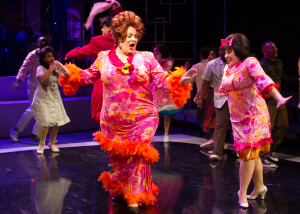‘Hairspray’ reshapes sounds, and issues, of early rock era
by Eric Marchese
 Could the unique sensibilities of cult figure John Waters, writer and director of the film “Hairspray,” be preserved in a Broadway musical? And can the stage version work without one of its hallmarks, the candy-colored sets?
Could the unique sensibilities of cult figure John Waters, writer and director of the film “Hairspray,” be preserved in a Broadway musical? And can the stage version work without one of its hallmarks, the candy-colored sets?
In Chance Theater’s new production, both questions receive a qualified “yes.” Mark O’Donnell and Thomas Meehan’s 2002 adaptation tones down the feel of Waters’ 1988 film from an R-rating feel to more of a PG – only fitting in light of the story’s era of the early ’60s.
Chance dispenses with the traditional “Hairspray” sets in favor of a three-quarter-round staging in which scenic designer Matt Scarpino has incorporated the entire space – not just the rectangular floor area but the four corner aisles and the areas behind the last rows of seats.
That opens up director Kari Hayter’s staging in ways not possible with a traditional proscenium. What’s lost is the innocent storybook feel the right sets can create. But watching Chance’s “Hairspray” enforces our focus on the show’s authentic-sounding early rock score and the cast’s top-notch musical theater skills.
Set in Baltimore in the spring of 1962, the musical looks at Tracy Turnblad (Taylor M. Hartsfield), a dance-crazy teen with seemingly nothing in her favor: Short, chunky and with impossibly high hair, she dreams of fame via “The Corny Collins Show,” a local weekly teen dance program.
Tracy’s high spirits and enthusiastic dance skills win her a regular spot in the show’s cast, a chance to interact with teen heartthrob Link Larkin (Cody Bianchi) and a possible shot at helping to integrate the all-white cast.
Standing in her way is Velma Von Tussle (Camryn Zelinger), the program’s bigoted producer, who aims to keep the races separate and her gorgeous but equally cutthroat daughter Amber (Ellie Wyman) in place as top female dancer.
Hayter’s staging and Kelly Todd and Christopher Albrecht’s choreography overcome the limited amount of performance acreage, often ingeniously so. As unusal as this “Hairspray” may be, Chance’s production will warm your heart and fill you with the urge to dance.
Mark Shaiman’s music and his and Scott Wittman’s lyrics create a winning score whose songs have the authentic sound of actual period rock. The duo have also written some first-rate Motown songs, including “Welcome to the ’60s,” “Big, Blonde & Beautiful,” and the socko “Run and Tell That,” which combines hot, exuberant dancing with the cool persona and killer vocals of Xavier J. Watson as Seaweed J. Stubbs.
“It Takes Two” has the authentic sound of a teen idol crooner-type song. The gospel number “I Know Where I’ve Been,” sung by LaJoi Whitten as Motormouth, is suitably powerful and stirring, and “You Can’t Stop the Beat,” the show-stopping finale, meshes the “old” Big Band sound with the “new” sound of rock.
The excitement, enthusiasm and energy of Hayter’s young cast – and of their characters – is positively infectious. Hartsfield is ideal as the heroically optimistic, generous and far-seeing Tracy. Her solid, no-frills vocals are perfect in songs like “Good Morning Baltimore” and “I Can Hear the Bells,” the latter expressing Tracy’s dreamy romantic stirrings over Link.
Where the nice-kid persona of Bianchi’s Link mirrors Hartsfield, the role requires an at-first slick public image, akin to Link being “the next Elvis,” that Tracy’s goodness transforms, making plausible the gradual shift in Link’s personality.
Zelinger’s Velma is a maniacally high-strung drama queen. Her and Wyman’s Amber are hilariously a lot more like snarky, platinum-blonde twin sisters than mother and daughter, and both deliver solid pop vocals. Following Waters’ use of a male actor in the role, Joe Tish has the right gruff deep voice and unfeminine mystique as Tracy’s triple-plus-sized mom Edna.
Sarah Pierce triumphs as Penny, Tracy’s nerdy, mousy best friend, whose crush on Seaweed opens her eyes to the music and lifestyles of her black peers. As Little Inez, Timyra-Joi looks like a little girl but has the dynamite vocals of a show-biz vet. Jordan Goodsell’s Corny is suitably plastic on camera but is otherwise the TV station’s most racially tolerant person.
Scarpino’s design scheme has a classic, monochromatic look that serves the story’s various settings, with rows of klieg lights above each section of seats and the fourth, upstage wall containing the seven-piece musical combo.
That onstage band, led by music director Robyn Manion on keyboard, easily navigates the score and its varying rock styles – underscoring the importance of the show’s musical score in punching across a message of racial tolerance, equality and brotherhood.
Leave a Reply

